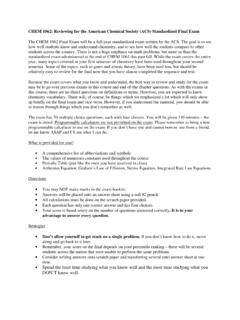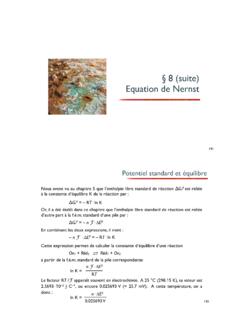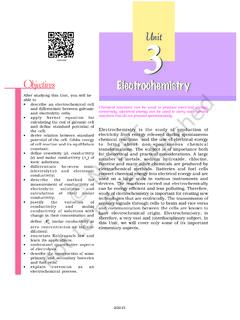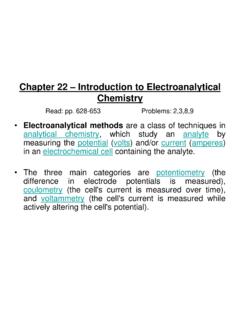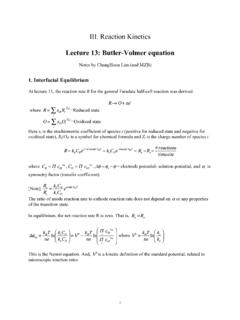Transcription of Calibration and Linear Regression Analysis: A Self-Guided ...
1 Calibration and Linear Regression Analysis: A Self-Guided TutorialPart 2 The Calibration Curve, Correlation Coefficient and Confidence LimitsCHM314 Instrumental AnalysisDepartment of Chemistry, University of TorontoDr. D. Stone (prepared by J. Ellis)1 The Calibration Curve and Correlation CoefficientEvery instrument used in chemical analysis can be characterised by a specific response function, that isan equation relating the instrument output signal (S) to the analyte concentration (C). This response functionmay be Linear , logarithmic, exponential, or any other appropriate mathematical form, depending on thenature of the behaviour of the system being measured, and the measurement process itself.
2 While this maybe known theoretically, various factors (such as the specific analyte being measured, interference effectscaused by other components of the sample matrix, or random experimental errors) require that we calibrateeach instrument for the specific analyte and measurement conditions to be used in a particular Calibration curve is an empirical equation that relates the response of a specific instrument to theconcentration of a specific analyte in a specific sample matrix (the chemical background of the sample). Aswith the instrument response function, the Calibration curve can have a number of mathematical forms,depending on the type of measurement being performed.
3 Some common examples are listed below:TypeEquationLinear (zero intercept)S = bCLinear (non-zero intercept)S = bC + aLogarithmicS = a + b ln C or S = a + log CThe Calibration curve is obtained by fitting an appropriate equation to a set of experimental data( Calibration data) consisting of the measured responses to known concentrations of analyte. For example, inmolecular absorption spectroscopy, we expect the instrument response to follow the Beer-Lambert equation,A = bC, and so we would fit a Linear equation with zero intercept to the data. On the other hand, if we weremeasuring electrochemical cell potentials ( potentiometry) we would expect the response to be given bythe nernst equation, which is logarithmic in form.
4 We would therefore either fit a logarithmic equation tothe Calibration data, or linearise the data by calculating the signal response S as 10E (where E is the cellpotential).The most common response function encountered in instrumental analytical chemistry is Linear , so werequire some means of determining and qualifying the best-fit straight line through our Calibration discussing this in detail, however, a word of caution: even when we expect a Linear instrumentresponse function, we should not assume that the Calibration data must always be Linear .
5 In fact, a momentof reflection reveals that we already know that this cannot be true. For example, stray light andpolychromatic radiation cause non- Linear deviations from Beer s law at higher concentrations; quenching andself-absorption can cause fluorescence intensities to start decreasing with increasing concentration; andcolumn- or detector-overload can cause non-linearities in and Linear Regression Analysis: A Self-Guided Tutorial (Part 2)CHM314 Instrumental Analysis, Dept. of Chemistry, Univ. of TorontoD. Stone, J. The Correlation CoefficientIn Part 1 of the tutorial, we saw how to use the trendline feature in Excel to fit a straight line throughcalibration data and obtain both the equation of the best-fit straight line and the correlation coefficient, R(sometimes displayed as R2).
6 There are in fact various correlation coefficients, but the one we are interestedin here is the Pearson or product-moment correlation coefficient (often simply referred to as the correlationcoefficient ). The Pearson R value provides a measure of the degree to which the values of x and y arelinearly correlated. We can assess this visually using a scatter plot (Figure 1), in which we also mark thecentroid of the data, x ,y {}. x ,y {}2468y2468xFigure 1 XY scatter plot showing the centroid of the dataIf x and y were linearly correlated, we would expect all the points to fall on a straight line passingthrough the centroid.
7 As a result, we would expect all x values to be uniformly distributed either side of x ;similarly, all the y values should be uniformly distributed about y . The Pearson R is calculated using theformula R=xi x ()yi y ()[]i xi x ()2i yi y ()2i It follows that if x and y are perfectly correlated in a Linear fashion, we would expect the value of R to beeither +1 or -1, depending on whether y increases (positive slope) or decreases (negative slope) with demonstrate how to calculate this formula in Excel, we return to our previous example offluorescence intensity data from Part 1.
8 Then,1. Set up a spreadsheet with the xi and yi values in columnsCalibration and Linear Regression Analysis: A Self-Guided Tutorial (Part 2)CHM314 Instrumental Analysis, Dept. of Chemistry, Univ. of TorontoD. Stone, J. Ellis32. In the adjacent cells, set up expressions for xi x (), yi y (), their squares, and their product. Forinstance, the formula for x2 x () may look like =B3-AVERAGE(B$2:B$8), depending on the locationof your cells in the Determine the sums of squares xi x ()2i and yi y ()2i , and the sum of products xi x ()yi y ()[]i in Excel and insert these values in the formula for To calculate the square root in the denominator, use the SQRT easiest way to calculate R in Excel is by setting up a table to calculate the required values, as shownbelow.
9 As you can see this, yields a correlation coefficient R2 = , so the data are well-correlated andthe best-fit line describes the few points to mention regarding the correlation coefficient:o It is essential to retain a large number of significant figures in the numerator and denominator duringthe calculation, otherwise a misleading value of R may be Even a high R value of, say, does not necessarily indicate that the data fits to a straight trendline should always be plotted and inspected visually. R2 is more discriminating in thisrespect, although it no longer indicates the slope of the Regression line.
10 This, however, is evident Any curvature in the data will result in erroneous conclusions about the correlation. R values are onlyapplicable to Linear correlations. Nonlinear correlations are possible, but involve a different measurethan R, and R values will not necessarily be close to The statistical significance of R depends on the number of samples in the data set The Regression LineCalculation of the Regression line is straightforward. The equation will have the form y = bx + a, where bis the slope of the line and a is the y-intercept. The slope is given by the formula b=xi x ()yi y ()[]i xi x ()2i and the intercept isCalibration and Linear Regression Analysis: A Self-Guided Tutorial (Part 2)CHM314 Instrumental Analysis, Dept.
